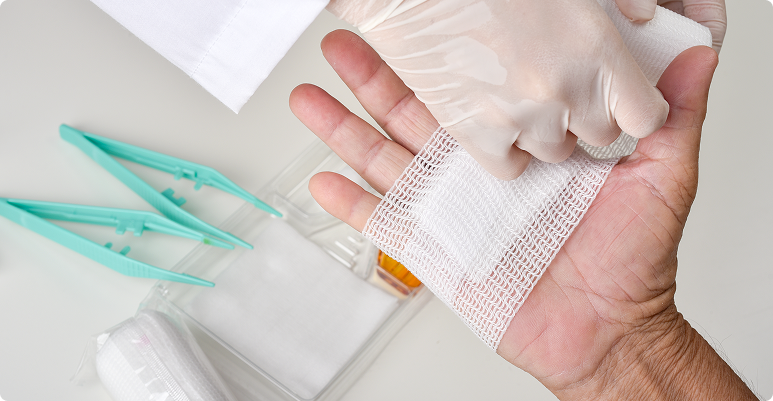Wound Dressing Changes

Wound Dressing Changes
Receive expert wound care treatment in the comfort of your own home with our QNB nurses. Avoid the hassle, expense, and potential exposure to hospital infections by opting for at-home care. Our skilled nurses specialize in treating both infected and surgical wounds, providing the gentle yet effective care necessary for optimal healing. With QNB, you get the convenience of saving time and effort, while ensuring the best possible treatment for your wound care needs.
what is Wound Care?
Wound dressing changes are a critical aspect of wound care, essential for promoting healing and preventing infection. Nurses and other healthcare professionals often perform this task, especially for patients who are unable to manage their wound care independently. Here’s an overview of how wound dressing changes are typically handled:
Assessment and Preparation
-
Wound Assessment: Before changing the dressing, the nurse assesses the wound for signs of healing or infection, such as redness, swelling, heat, pain, or discharge.
-
Gather Supplies: Supplies include clean gloves, sterile dressing materials, wound cleanser or saline, a waste bag, and potentially an antimicrobial or other topical agents as prescribed.
-
Hand Hygiene and PPE: The nurse performs hand hygiene and dons appropriate personal protective equipment (PPE) like gloves, and possibly a gown or mask.
Removing the Old Dressing
-
Careful Removal: The nurse gently removes the old dressing, being careful not to cause pain or disrupt the healing process.
-
Wound Inspection: Once the old dressing is removed, the wound is inspected more closely for any changes.
-
Cleaning the Wound: The wound is then cleaned gently with a suitable cleanser or saline solution to remove debris and exudate.
Applying the New Dressing
-
Drying the Area: The area around the wound is gently patted dry.
-
Applying Medication or Treatment: If prescribed, topical medications are applied.
-
Placing the New Dressing: The nurse applies a new, sterile dressing. The choice of dressing depends on the wound type, location, size, and exudate level.
-
Securing the Dressing: The dressing is secured with tape or a bandage, ensuring it's snug but not too tight.
Common Types of Wounds?
our certified and highly trained nurses are dedicated to providing prompt and professional wound dressing changes right in the comfort of your home. Whether it's managing bed sores, post-surgery wounds, malignant wounds, or diabetic wounds, our team is equipped with the expertise and experience necessary for meticulous care. We ensure that our nurses are dispatched swiftly to address your wound care needs with the highest level of attention and professionalism, prioritizing your comfort and healing.
-
Bed sores
-
Post-surgery wound
-
Malignant wound
-
Diabetic wound
How can our nurses help?
Our nurses at QNB are highly skilled and trained to provide exceptional care for wound dressing changes, ensuring both safety and comfort for the patient. Here's how our nurses can help in the process of changing wound dressings:
-
Personalized Assessment
-
Professional Wound Cleaning
-
Appropriate Dressing Selection
-
Pain Management
-
Infection Prevention and Control
-
Education and Guidance
-
Monitoring and Follow-up Care
-
Emotional Support and Reassurance
-
Coordination with Healthcare Providers
-
Convenience and Comfort
Our QNB nurses are committed to delivering high-quality, compassionate care to ensure the best possible outcomes for our patients’ wound healing journeys.

Why do feeding tube insertions at home?

Save your Time
Avoid long waits and reduce the risk of infections in the hospital

Comfort and privacy
Nursing procedures can be done in the comfort of your home with the same level of effectiveness as in the hospital

Faster response time
We are able to get a nurse to you in as quickly as 2 hours (urgent charges may apply)

Lower overall cost
No hefty ambulance and A&E fees